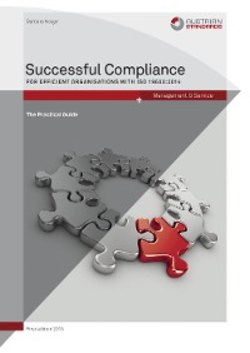Читать книгу Successful Compliance - Barbara Neiger - Страница 4
ОглавлениеInhalt
Foreword
Abbreviations
1 Basic principles and general framework
1.1 Definition of the term ‘compliance’
1.2 Legal framework for compliance in organsations
1.2.1 Responsibility of organisations in the international arena
1.2.2 Responsibility of organisations at the national level
1.2.3 Responsibility for compliance in Austria
1.3 Compliance as a tool of strategic management
1.3.1 Definition of management systems
1.3.2 Compliance Management Systems
1.4 Distinction between corporate governance – ICS – RMS – CMS
1.4.1 Corporate governance
1.4.2 Internal control system (ICS)
1.4.3 Risk management system (RMS)
1.4.4 Compliance management system (CMS)
1.5 Standardisation of management systems in accordance with ISO
1.6 Certification
1.6.1 Importance of the certification of a CMS
1.6.2 Certification under ISO
2 A CMS in accordance with ISO 19600 at a glance
2.1 Positioning of ISO 19600 as a best-practise approach
2.1.1 Positioning of ISO 19600 compared to legal requirements
2.1.2 ISO 19600 in comparison with selected management tools
2.2 Approach for the implementation of a CMS in accordance with ISO 19600
2.2.1 PLAN – Preparation
2.2.2 DO – Implementation
2.2.3 CHECK – Verification
2.2.4 ACT – Improvement
3 Elements of ISO 19600 – compliance management systems
3.1 Introduction
3.2 Area of application of the ISO 19600 standard
3.3 Definitions in accordance with ISO 19600
3.4 Context of the organisation
3.4.1 Understanding the organisation and its context
3.4.2 Understanding the needs and expectations of interested parties
3.4.3 Determining the scope of the compliance management systems
3.4.4 CMS and principles of good governance
3.4.5 Compliance obligations
3.4.6 Identification, analysis and evaluation of compliance risks
3.5 Leadership
3.5.1 Leadership and commitment
3.5.2 Compliance policy
3.5.3 Organisational roles, responsibilities and authorities
3.5.4 Management responsibility
3.5.5 Employee responsibility
3.6 Planning
3.6.1 Actions to address compliance risks
3.6.2 Compliance objectives and planning to achieving them
3.7 Support
3.7.1 Resources
3.7.2 Competence and training
3.7.3 Awareness
3.7.4 Communication
3.7.5 Documented information
3.8 Operation
3.8.1 Operational planning and control
3.8.2 Establishing controls and procedures
3.8.3 Outsourced processes
3.9 Performance evaluation
3.9.1 Monitoring, measurement, analysis and evaluation
3.9.2 Audits
3.9.3 Management review
3.10 Improvement
3.10.1 Nonconformity, non-compliance and corrective measures
3.10.2 Escalation
3.10.3 Continual improvement
4 Guide for small and medium-sized enterprises (SMEs)
4.1 Compliance-relevant characteristics of SMEs
4.2 Implementation and configuration of compliance management in the SME sector
4.3 Conclusion
5 Advanced concepts
5.1 Change management as a management tool
5.1.1 Definition of change management
5.1.2 Reasons/drivers for change management processes
5.1.3 Factors influencing change management processes
5.1.4 Three-phase approach to changes according to Lewin
5.1.5 Leading Change – The 8-Step Model by John Kotter
5.1.6 Change management and a CMS in accordance with ISO 19600
5.2 Organisational culture as a management tool
5.2.1 Influences on organisational cultures
5.2.2 Characteristics of organisational cultures
5.2.3 The cultural model according to Schein
5.2.4 Effect and function of organisational cultures
5.2.5 Measurement of organisational cultures – the model by Denison
5.2.6 Organisational culture and a CMS in accordance with ISO 19600
5.3 Risk management
5.3.1 A brief history of risk management
5.3.2 Risk management systems at a glance
5.3.3 ERM – a holistic, organisation-wide risk management system
5.3.4 ISO 31000 Risk Management
5.3.5 Risk management and a CMS in accordance with ISO 19600
6 Summary and forecast
Bibliography
The author
